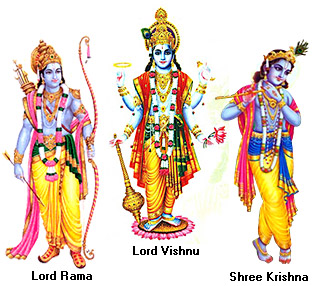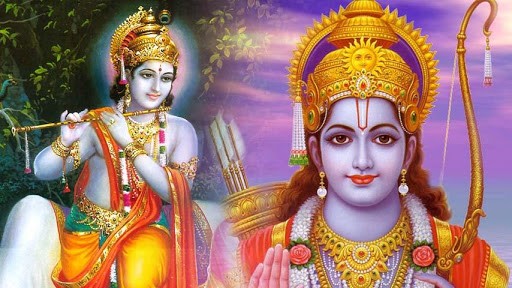A rose by any other name would smell as sweet. – By Juliet from the play “Romeo and Juliet” by William shakespeare
A rose is a rose is a rose. –From the poem “Sacred Emily” by Gertrude Stein
You may call Him by any name you like, but the Truth is always one and the same. – Swami Ramdas
———————-

However you cut it, names of the avatars in Hinduism are simply seen as different manifestations of the divine energy. So whether you worship Sri Rama or Sri Krishna or Sri Devi – they all are simply different names to address your favored God.
Well, this is not the case with two of the most popular avatars for Hindu devotees – Rama and Krishna. Let’s see, shall we, if there is more to them than just different names.
At a superficial level, the resemblance is almost striking. Both of them born to royalty, both the apple of their parents’ eyes, both born to vanquish evil, both fighting asuras and demons at every turn, both poorna avatars of Maha Vishnu, and both evoking infinite devotion. And then the differences begin:
1. Kodhanda Rama versus Bansuri Walla: As divine brands!
Rama is known for his fighting prowess, as exemplified by his divine bow, Kodhanda. Instructed by Vishwamitra, his skills in the battle are second to none. Most of his images and idols are incomplete without the bow. It represents might, strength and the desire to fight on behalf of the oppressed. On the other hand, Krishna does not really care to be known for his skills on the battle-field. Wielding his flute and mesmerizing the gopis seems to be his main claim to capturing the minds of his devotees. His images and idols invariably carries the flute, a symbol of total surrender to the Almighty.
2. Sita-Ram versus Radhe-Shyam: As husbands
Ram is a one-woman man. He has sworn to be the ideal husband. But what emerges is his inability to reconcile Dharma with his personal life. Again and again, during the agni pariksha and banishment to the forest, his actions towards Sita appears too cruel to digest. He appears to listen to the common man, but not his loved ones. We cannot fathom his addiction to the letter of the law he has sworn to uphold. On the other hand, Krishna has no qualms. Whoever cries to him in distress, he accepts. When faced with public ostracizing since they were kept in capture by Narakasura, 16,000 princesses appealed to Krishna to save them. Ignoring his personal wishes (and that of the society), he openly accepts them as his queens since he believes that is the only way to save the princesses from a fate worse than death.
3. Ram Bhaiyya versus Kanhaiya: As brothers
Rama is the unbending, strict adherent to dharma. His brothers struggle with his decisions and do their best to live up to his expectations of them. But no matter how harsh the circumstances, they never leave his side. They are with him until death. On the other hand, Krishna is in constant altercations with his older brother Balarama – whether it is about their sister Subhadra’s marriage to Arjun or the way they defeat the Kauravas. In fact, Balarama refuses to support Krishna during the mahabharat war and takes off for a pilgrimage instead. How does this end? Rama kills his brother Lakshmana (Adi Sesha himself) while Krishna decorously requests Balarama (again Adi Sesha) to “go” first to Vaikunta.
4. Asura nikandana versus Ranachora: As strategists
Rama believes in straight-forward fighting. He never flinches from battle, and his strategy is very clear. String bow, release arrow, kill demon. Rinse. Lather. Repeat. Until no demon is left standing. On the other hand, our man Krishna has only one strategy – win at any cost. He runs from the battle field against Jarasandha, uses magic to make the sun set so Jayadrath can be killed, connives and deceives to kill Drona, Karna and Duryodhana – the list is endless!
5. Dasharatha Nandana versus Vaasudeva: As sons
Rama is the ideal son. He never gives his parents a moment’s distress. No matter what the cost, he follows his parents’ wishes. While not much is said about his childhood, we know mother Kausalya wakes him up every day with a song requesting him to do his duty of showering prosperity on his subjects – “Kartavyam Mangalam Kuru“. Must be one tough lullaby! On the other hand, Krishna never does what his parents wants. He defies, rants, steals, mocks, and leads them on a royal chase all over Gokul and Vrindavan. Imagine waking up in the middle of the night to hear that your son is frolicking with the gopis in the Kalindi river? Heaven help the mother!
6. Maryada Purushottama versus Pushti Purushottama: As avatars
If by now I have not alienated my devotee readers, let me amp it up a notch by rating Rama and Krishna as avatars. To me, it appears that Rama seems to have forgotten that he is God. He struggles to find his place. Is he a mere mortal or a God posing as human? Dharma becomes all-important in this struggle and at all times, his aim is to become the ideal man in the society, wanting to lead by example. This is how men ought to live – seems his message to his devotees. On the other hand, Krishna never forgets for a moment that he is God. He is not interested in leading a life of rectitude or morality. He is beyond the silly rules that humans have concocted. He is beyond judgement, definition or strictures. He dictates, blesses, warns, advices and loves – and no matter what he does, his only aim is to destroy evil and protect his loved ones. *As the title implies, Maryada Purushottama refers to Divinity restricted by Laws, while Pushti Purushottama refers to the Divinity that bestows grace in ways that are not bound by laws or social norms.
So what’s in a name? Apparently a lot. Or nothing much. Depending on the God you relate to, you will convert all his so-called negatives into positives, and insert divine qualities and meanings to his every action. And no matter what you read, you are unswayed and unconvinced. And isn’t that what faith is all about?
Jay Sri Rama. Jay Sri Krishna.
References:
*Definition of the avatars from Narayaneeyam, by Meppathur Narayana Bhatttathiri, translated into English by Swami Tapasyananda
Image courtesy: http://www.indianetzone.com

